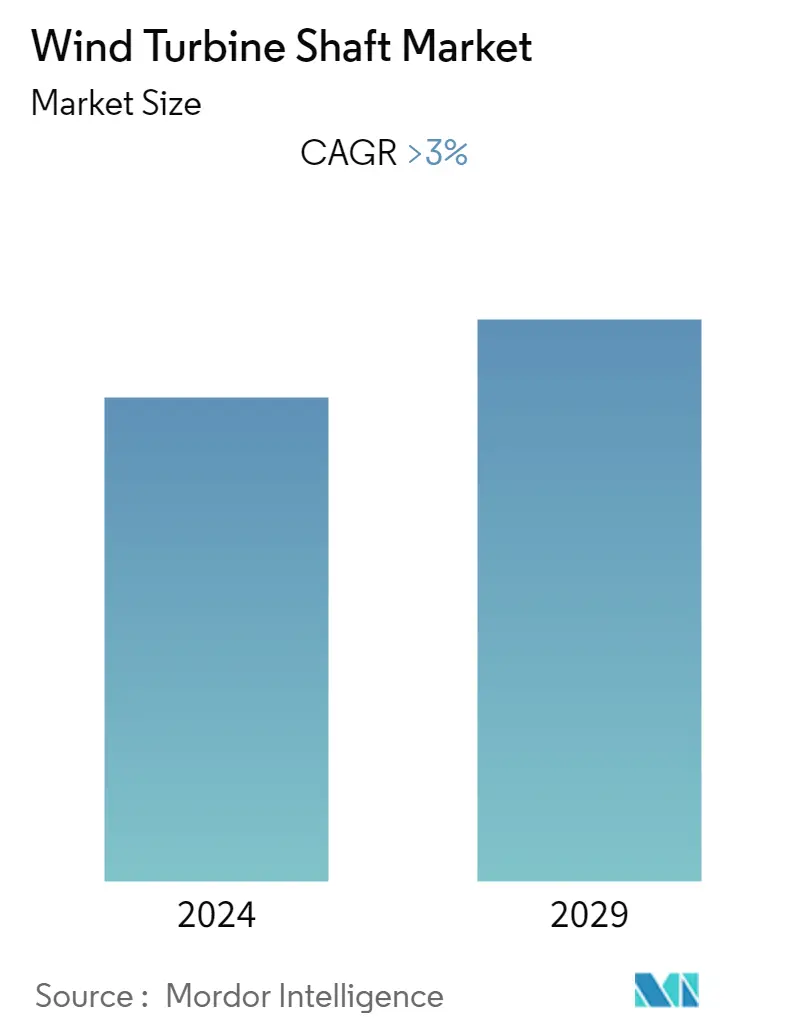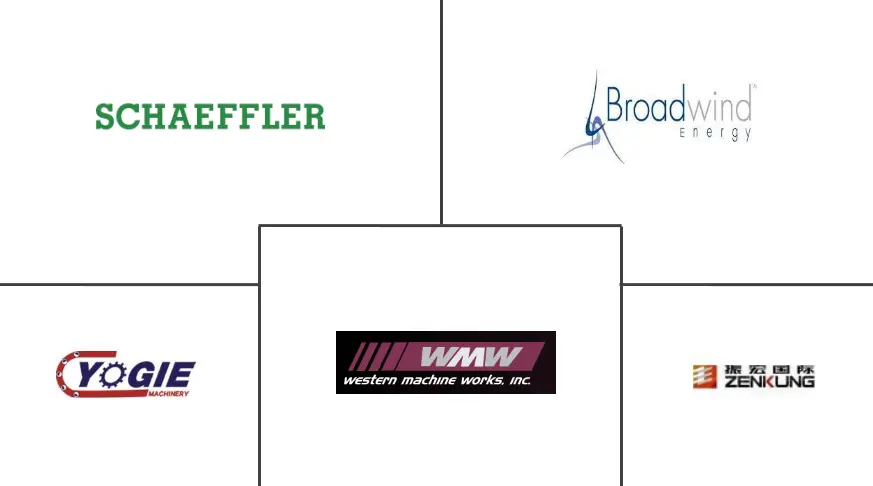Market Size of Wind Turbine Shaft Industry

| Study Period | 2020 - 2029 |
| Base Year For Estimation | 2023 |
| CAGR | 3.00 % |
| Fastest Growing Market | Asia Pacific |
| Largest Market | Asia Pacific |
| Market Concentration | Low |
Major Players
*Disclaimer: Major Players sorted in no particular order |
Wind Turbine Shaft Market Analysis
The wind turbine shaft market is expected to follow the trends of wind turbine tower market which is growing at a CAGR of more than 3% during the forecast period. Increase in wind tower market, is certain to increase the wind turbine shaft market at around similar rate. With rising CO2 emission and carbon footprint, the governments of various countries and international bodies are giving more emphasis on alternate fuels, like wind to generate an ecofriendly form of energy that is expected to help to achieve an imperishable form of energy and security in the coming years. The global wind power installations increased from 159 GW in 2009 to 591 GW in 2018. The overall growth of wind turbine shaft installations is primarily driven by declining costs, due to improved materials and design, and favorable government policies for wind power in major wind power countries, such as China, the United States, Denmark, Germany, the United Kingdom, and India. Moreover, the rising initiatives to have alternate sources of energy, such as wind, helps to drive the wind turbine shaft market. However, the emerging of other alternative energies such as solar and the dominance of hydropower energy would act as a restrain for the wind turbine shaft market to grow in the near future.
- The wind turbine shaft market in Asia-Pacific (especially the South-Eastern countries), is expected to have an immense opportunity, in untapped areas. The rising demand for energy in the south-eastern countries of Asia-Pacific depends upon economic growth, increasing population, and urbanization. The governments in these countries have set a target for wind energy deployment that would drive the Asia-Pacific wind turbine shaft market and is expected to create an opportunity for the market to grow in the future.
- The onshore turbine is the leading and dominating segment among the wind turbine market. The segment has the majority share from the Asia-Pacific region, with China as the leading player.
- The Asia-Pacific is one of the prominent wind turbine shaft markets with maximum wind energy installation capacity. China is a prominent country within the region that covers the majority market share of wind turbines. With nearly 36% and 20% of the total onshore and offshore wind turbine installed capacity, the country is dominating the wind turbine shaft market.
Wind Turbine Shaft Industry Segmentation
The wind turbine shaft market report include:
| Location of Deployment | |
| Onshore | |
| Offshore |
| Geography | |
| North America | |
| Asia-Pacific | |
| Europe | |
| South America | |
| Middle-East and Africa |
Wind Turbine Shaft Market Size Summary
The wind turbine shaft market is poised for growth, closely following the expansion of the wind turbine tower market. This growth is driven by the increasing emphasis on renewable energy sources, such as wind power, to combat rising CO2 emissions and carbon footprints. Governments and international bodies are prioritizing wind energy as a sustainable solution for energy security. The market benefits from declining costs due to advancements in materials and design, alongside supportive government policies in key regions like China, the United States, Denmark, Germany, the United Kingdom, and India. However, the emergence of alternative energies such as solar power and the dominance of hydropower present challenges to the market's expansion.
The Asia-Pacific region, particularly Southeast Asia, offers significant opportunities for the wind turbine shaft market due to rising energy demand driven by economic growth, population increase, and urbanization. Governments in this region are setting ambitious targets for wind energy deployment, which is expected to propel market growth. The onshore turbine segment remains the dominant force in the market, with China leading in both onshore and offshore wind energy installations. The region's substantial installed capacity and ongoing projects indicate a promising future for the wind turbine shaft market, despite the current dominance of coal-powered plants. Key players in this fragmented market include Schaeffler Technologies AG & Co. KG, Jiangyin Zenkung Forging Co., Ltd, and others, contributing to the competitive landscape.
Wind Turbine Shaft Market Size - Table of Contents
-
1. MARKET OVERVIEW
-
1.1 Introduction
-
1.2 Renewable Energy Mix, 2018
-
1.3 Wind Power Installed Capacity and Forecast in GW, till 2025
-
1.4 Market Size and Demand Forecast in USD billion, till 2025
-
1.5 Recent Trends and Developments
-
1.6 Government Policies and Regulations
-
1.7 Market Dynamics
-
1.7.1 Drivers
-
1.7.2 Restraints
-
-
1.8 Supply Chain Analysis
-
1.9 Industry Attractiveness - Porter's Five Forces Analysis
-
1.9.1 Threat of New Entrants
-
1.9.2 Bargaining Power of Consumers
-
1.9.3 Bargaining Power of Suppliers
-
1.9.4 Threat of Substitutes Products/Services
-
1.9.5 Intensity of Competitive Rivalry
-
-
-
2. MARKET SEGMENTATION
-
2.1 Location of Deployment
-
2.1.1 Onshore
-
2.1.2 Offshore
-
-
2.2 Geography
-
2.2.1 North America
-
2.2.2 Asia-Pacific
-
2.2.3 Europe
-
2.2.4 South America
-
2.2.5 Middle-East and Africa
-
-
Wind Turbine Shaft Market Size FAQs
What is the current Wind Turbine Shaft Market size?
The Wind Turbine Shaft Market is projected to register a CAGR of greater than 3% during the forecast period (2024-2029)
Who are the key players in Wind Turbine Shaft Market?
Schaeffler Technologies AG & Co. KG, , Jiangyin Zenkung Forging Co., Western Machine Works Inc., Broadwind Energy Inc and Luoyang Yujie Industry & Trade Co. Ltd are the major companies operating in the Wind Turbine Shaft Market.

